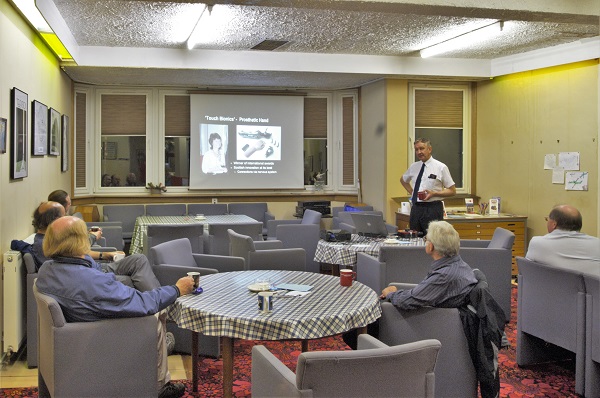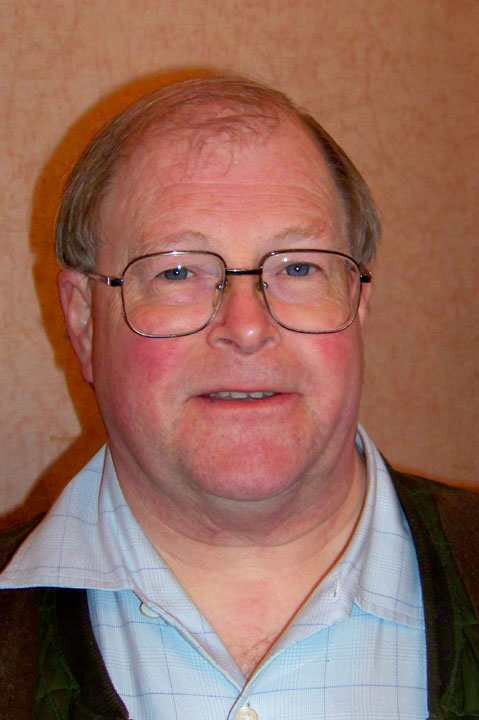- Details
- Written by Alan GM3PSP
- Hits: 3571
In his Presidential Address John began by explaining that his main interests in amateur radio are VHF and up, simple "home brew" radio equipment, and portable operation. He talked about how he got started in the hobby and how limited facilities for aerials at home had led him to portable operation including SOTA – Summits on the Air - and the need to build his own equipment tailored to these requirements.

Read more: 8 Sep 2010 - Home-Brew Stroke-P by John Cooke GM8OTI
- Details
- Written by Alan GM3PSP
- Hits: 3569
The LRS made its annual visit to the Museum of Communication in Burntisland, Fife on Wed 22nd Sept 2010. A group of members met at Waverley station and travelled by train to the museum via the Forth Bridge. This group met the rest of the party at the museum. The Lothians members were warmly welcomed by Dorothy Brankin and Professor Tom Stevenson. We saw the current exhibition which is More Great Scots - Mary Somerville, the 19th century astronomer, mathematician, artist, geographer, translator and "local hero". We were given open access to the stores which brought back to life stories and associations linked to some of the artefacts. We were also given a customised presentation by Professor Stevenson based on material used in the Orkney Science Festival. Refreshments were provided, rounding off a most enjoyable and informal evening. Many thanks to Dorothy and Tom who dedicated their time to making us most welcome. Report by Peter GM4DTH and photos by David GM4ZNX.

Prof Tom Stevenson giving his presentation
Read more: 22 Sep 2010 - Visit to Museum of Communication, Burntisland
- Details
- Written by Alan GM3PSP
- Hits: 5221
There was an excellent turnout of 17 for Brian’s talk on the history and update of the GB3EDN 23 cm beacon. He described the development of the current GB3EDN beacon which has been in almost continuous operation for 32 years since its installation in 1978 at the Faraday Building at the Kings Buildings campus of the University of Edinburgh. A simple design, with an under-run varactor tripler (5-watts on 1296.990 MHz) and plenty of heat-sinking, has proven to be very reliable with only two short outages during its history.
The beacon was originally licenced for use with two corner-reflector antennas beaming NE and NW, giving good coverage of central and north Scotland and the North Sea. A new antenna consisting of a vertical waveguide with multiple slot-feeds was installed in 1986, providing an omnidirectional horizontal radiation pattern. Brian showed a map of reception reports from a number of Scandinavian countries (see below).
The motivations for the new design included improved frequency accuracy and stability, reduced power consumption and improved keying with QRA locator added. A number of drawbacks precluded the use of conventional direct digital synthesis (DDS) and so Reverse DDS (RDDS) was chosen instead. This uses a DDS chip as the divider in a conventional phase-locked loop (PLL). Conveniently, the UK Microwave Group provides a suitable printed circuit board to implement RDDS circuitry. This was designed by Sam Jewell G4DDK who writes the RSGB RadCom “Microwaves” column. A multi-section interdigital bandpass filter will be added to ensure spectral purity. The new beacon is not yet complete. Brian hopes to have it operational on the air by next spring. (Alan Masson GM3PSP)

Brian GM8BJF with the hardware for the updated 23 cm beacon.
Read more: 6 Oct 2010 - GB3EDN 23 cm Beacon by Dr. Brian Flynn GM8BJF
- Details
- Written by Alan GM3PSP
- Hits: 3715
The autumn Junk Sale was held as usual in the St Fillans Church Hall in Buckstone Drive, by the kind arrangement of Pete GM4BYF. There was a good turn-out of members and visitors from other clubs. Lots of good "stuff" was sold, producing some useful income for club funds. The first prize in the raffle, a bottle of whisky, was won by Brian GM8BJF. A straw poll of those attending was taken and there was agreement that a second Junk Sale should be held in the spring, as in the past.
Photographs by Peter GM4DTH and Alan GM3PSP:

"The Management" - Chairman John GM8OTI and Treasurer Peter GM4DTH,
welcoming members and visitors to the Junk Sale.
- Details
- Written by Alan GM3PSP
- Hits: 5212

John Macdonald GM4XZN filled the meeting room at the Braid Hills Hotel on 10th November for his talk "GPO Vans in the Queerest of Places". Using a Powerpoint presentation and many 35mm slides, he described the development of the telegraph network in the north of Scotland, Orkney, Shetland and the Western Isles from the 1870s, including his own work in the 1950s onwards.
Prior to 1870 a limited number of telegraph lines were carried on the poles of the railway companies, but there was a dispute concerning payment for the railway poles when the GPO proposed to extend the network with additional lines. The Telegraph Act of 1868 was then passed to enable "... Her Majesty's Postmaster General to acquire, work and maintain Electric Telegraphs" as a government takeover and monopoly. Many additional lines were installed from 1870 onwards, using the Royal Engineers to provide the manpower in many cases. On land these were overhead lines, usually single-wires, carried on new poles. Under-sea cables were laid across straits and to islands using guttapercha-insulated cables, with diamond-shaped beacons indicating the locations on the shore. Equipment included morse-keys, sounders, the "ABC Instrument" used to provide a visual indication of the characters sent, and fault-finding equipment such as the megger, which could locate a fault on a long line with remarkable accuracy. Gradually telephony replaced telegraphy, with the last Morse Code message being sent by the GPO in 1934.
John showed slides of himself and his colleagues and their GPO vans at the many locations in the highlands and islands in a presentation which was much appreciated by all present.
Read more: 10 Nov 2010 - GPO Vans in the Queerest of Places, by John Macdonald GM4XZN
- Details
- Written by Alan GM3PSP
- Hits: 3188

With the cancellation by the scheduled speaker due to family illness, Peter Dick GM4DTH stepped in at a moment's notice and organised the showing of DVDs of a selection of classic short ducumentary films made in the 1930s by the GPO Film Unit. These were related somewhat to the talk at the previous meeting by John Macdonald about GPO Vans in The Highlands. The titles shown were the following:
- The Coming Of The Dial 1933
- Sixpenny Telegram 1935
- Calendar Of The Year 1936
- Night Mail 1936
- Roadways 1937
- A Midsummer Day's Work 1939
The program was much enjoyed by all present and the LRS President, John Cooke thanked Peter Dick for being willing to put together such a good show at such short notice.
- Details
- Written by Alan GM3PSP
- Hits: 3747
The Lothians' traditional Christmas Curry was held at the Himalaya Tandoori Restaurant at Bruntsfield Place, Edinburgh on Wednesday 8th December. A great time was had by all the 18 LRS members and partners present.

Pete GM4BYF, XYL Nubia & OM Norrie GM1CNH
- Details
- Written by Alan GM3PSP
- Hits: 3798
The first meeting of the Lothians Radio Society in 2011 was a Video Night, presented by Peter Dick GM4DTH on 12th January 2011. Peter showed the 1959 BFA award-winning documentary "This is the BBC - an impression of Twenty-Four Hours in the Life of the British Broadcasting Corporation". The film went down well and raised quite a few laughs as well.
Page 1 of 3

